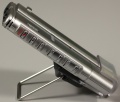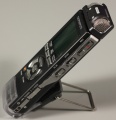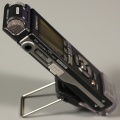Digital Voice Recorders Quick Guide
OLYMPUS WS100 RDV (MONO, WMA files) - recommended for PC users
OLYMPUS DS-30 RDO (STEREO, WMA files) - recommended for PC users
SONY RDS (STEREO, MP3 files) - recommended for Mac users
Files recorded with the Olympus Digital Recorders can be transcribed using ExpressScribe. Olympus Recorder with ExpressScribe PDF
Contents
Suggested Recording Checklist for all Devices
- Make a test recording prior to your scheduled interview to make sure you are comfortable using the recorder. Start with fresh batteries.
- Select a controlled and quiet recording location. Avoid noisy public locations (like restaurants, or areas near a road). If possible, eliminate background noises (turn off stereos, TV’s, fans, air circulation vents). A room with carpeting and furniture will typically sound better than one with hard floors (too much echo).
- Check record levels. Improve the quality of the recording by adjusting the mic placement either closer, or further away from the sound source. Wear headphones to monitor volume levels as well watch the volume meters on the recorder. Ideal recordings will have clearly audible audio, while not being too loud so that it is distorted (going into "the red" on the audio recorder meters). What you hear is what you get. Shock mounts and stands are great to reduce mic handling noise.
- Confirm you are recording. Make sure the record light comes on, that the clock numbers are counting and audio levels are moving up and down.
- Tag the recording. Start each recording by stating the date, time, location, your name, and the name of your interviewee for proper archiving and cataloging of this work.
Steps for Saving Files
- Copy files from the audio recorder to a computer as you would from a USB drive. Protect the privacy of your recordings by deleting all files on the recorder before returning equipment to Media Loan.
- Backup the original audio files from the recorder to your program network drive. DO NOT USE SPECIAL CHARACTERS IN FILE NAMES (‘!#$*&%).
- When working with files in an audio editing program like Audacity, create a copy of the originals to be able to revert back if necessary.
Connecting Recorders to a PC/MAC
- Before connecting one of the PC compatible devices, make sure power switch is OFF and the display is off.
- Then plug it into an open USB port. Computers will recognize the recorder as a removable disk drive.
- Files are saved onto the recorder in WMA format on Olympus recorders (a program which can read WMA files is required) and in lettered folders corresponding to the folder in which you recorded.
- When connected the recorder display will read “PC” When transferring data, the display will read “BUSY”. DO NOT disconnect the recorder when either message is displayed on the screen.
- BEFORE DETACHING FROM COMPUTER - Remove the detachable device (Eject in Mac OS) and make sure the display is turned off.
Olympus WS100 RDV
Basic Menu Operations
Press and hold menu for 1 second or longer while recorder is stopped. Press FF or REW to browse menu options, and PLAY to select an option or to close the menu hit the STOP button at any point.
Recording
- Press the FOLDER button to choose folder
- Press the REC button to start recording
- Press STOP button to stop recording
Playback
- Press the FOLDER button to choose folder
- Press the FF or REW to choose the file you want to play
- Press PLAY button to start playback
- Press VOL (+) or VOL (-) button to select proper volume (Between 1-30)
Helpful Tip: To change the playback speed press PLAY to toggle between regular, slow, and fast.
Erasing Files
- To erase an individual file press the FOLDER button to choose a folder
- Press the FF or REW button to choose the file you want to erase
- Press the ERASE button for less than 3 seconds ‘
- Press the ERASE button again (“DONE” blinks for two seconds and the deletion will be complete)
Tips
- When using headphones while recoding or to listen to a recoding, the volume can be adjusted by pressing VOL (- +)
- To Pause press the REC button during recording; PAUSE will appear on the display and the recoding lamp flashes
- If a external microphone is desired, connect to headphone jack. Recommended external mics for this device are omnidirectional sound grabber, lavalier (MOT/MOE)
Possible Issues
- If full appears on the screen the device is out of memory. Erase unwanted files to make more room for new recordings.
- If recorder is stopped for 5 minutes, it will go on standby and the display will shut off. Recorder will also stop if left un-paused for 60 seconds. To exit standby mode press any button.
Olympus DS-30 RDO
Basic Menu Operations
- Press the MENU button for 1 second or longer to open the menu.
- Menu items can be set during a recording or playback.
- Press the + or – button to scroll through the menu. Press the OK button to change the setting of the selected item. Press the OK button to complete the setup screen.
- If the REW button is pressed, the setting will be canceled and it will return to the menu. Press the STOP button to close the menu.
Power/Hold
- Push the POWER/HOLD button up to initiate hold and down to turn recorder on. Push POWER/HOLD button down again to turn recorder off.
- When in hold, all functions will remain as they are set. For example, if hold is on when recording, you cannot stop or pause recording until hold is turned off.
Recording/Playback
- Press FOLDER button to select folder to record into. Use the +/- buttons to navigate to different folders.
- Once folder is selected, press the REC button the the right side to start recording .To pause, press REC button again.
- To play the recording back, select file and press PLAY button the right side of the recorder. This is also where the STOP button is located.
Recording Modes
While the recorder is stopped, open the menu. Select “Rec Mode”. Choose from “ST XQ”, “ST HQ”, “HQ”, “SP” and “LP”.
Erasing Files
Select file within folder and press the orange ERASE button on the bottom left.
Tips
- Mic sensitivity allows you to choose three different settings. Slide the MIC SENSE switch and select “LECTURE”, “CONF.”, “DICT.”. Lecture is the highest recording quality suitable for conferences with large crowds, or recording at a distance. Conference is suitable for meetings with small amount of people. Diction is the lowest recording sensitivity suitable for dictation.
- Voice filter is a function to cut low and high frequency tones during normal, fast, or slow playback, and enables clear audio playback.
- Noise cancel is a setting to use if audio is difficult to understand because of noisy surroundings. Menu options are high, low, and off and can be set while stopped or during playback.
Sony RDS
Basic Menu Functions
- Press the MENU/FOLDER button to open folder list.
- Use FF/REW buttons on side to scroll through list.
- Use the PLAY/STOP button on the side to select folder.
- HOLD button is on back of recorder.
- The HOLD button is also the POWER switch. Use it to turn the recorder on and off.
- When in hold, all functions will remain as they are set. For example, if hold is on when recording, you cannot stop or pause.
- Recording modes can be altered by using the menu and selecting either LOW or HIGH.
Recording/Playback
- Select folder to record into.
- When ready to record, press large red circular button on the right side of the recorder labeled REC PAUSE (located on underside of recorder).
- To pause recording, press the REC red button once again.
- To play back recoding, hit the STOP button on the side of the recorder which will put you back at the folder. Press the PLAY button to play back recording.
Erasing Files
- To erase files, select folder and file. Press the small red circular button on the left side to erase.
- Hold button down for 1 second or longer and file will be deleted.
Tips
- DPC: When you slide the DPC (Digital Pitch Control) switch to “ON”, you can adjust the playback speed between +200% and -75% of normal speed in the menu. The message is played back in natural tones by this function.
- Slide the DPC switch to ON.
- Press and hold MENU button to enter menu. Use REW/FF buttons to select DPC then press PLAY. Press STOP to exit.
- Slide switch to OFF position to return to normal playback.
- NOISE CUT: When NOISE CUT switch is set to ON, the distortion of very low frequencies which are outside the human voice range is reduced, therefore you can hear the human voice more clearly. However, when you are using the built in speaker this function is not available.
- Slide the NOISE CUT button to the ON/OFF position.
- Recording time with different formats: WAV 44/16 = 3 hours and 10 minutes of recording available | WAV 22/16 = 6 hours and 20 minutes of recording available. MP3 192K = 23 hours of recording available | MP3 128K = 35 hours of recording available.







